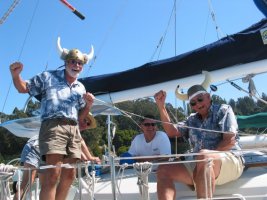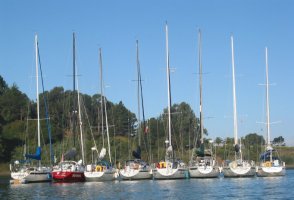USCG Vessel Safety Check Guidelines
All,
To those interested in the Ericson rendezvous on the weekend of July 23rd/24th, I've volunteered to conduct USCG Vessel Safety Checks and award stickers to those who pass. I’m more than happy to take the time to inspect all the vessels that are interested in the safety check. It's about a 15-20 minute operation and may help on your insurance policy. In addition, Law Enforcement and USCG are more apt to pass on boarding a vessel with the sticker unless there is an obvious violation observed, but there are no guarantees!
To make the process as easy as possible and allow as many of those interested in passing the check here are the basic requirements:
1. Original and current CA vessel registration must be onboard and the display of CA numbers must be block numbers on the forward portion of the port and stbd side of the hull and meet the 3" height requirements with a current CA registration sticker.
2. If USCG Documented, the original and current Certificate of Documentation (CoD) must be on board, with the vessel's name and hailing port affixed to the stern which must be clearly legible and not less than 4" in height. In addition, the official number must be permanently attached to a structural member of the vessel such as an engine stringer or deck beam which is easily visible with numbers not less than 3" in height. The Official number must be proceeded by "No." followed by the official CoD number (e.g. "NO. 123456").
3. Personal Flotation Devices - There must be a PFD for every member of the crew and passengers on board and if an inflatable Type V, it must be worn to count as applicable to the total count. Keep in mind, if any children are on board, there must be an adequate number of child PFD's on board as well. In addition, CA law requires any vessel less than 26' in length to have a child wear a PFD at all times if under 11 years or younger if on deck unless tethered to the boat or underneath in the cabin. All Type I’s, Type II's or Type III or V are acceptable in if serviceable condition and USCG approved.
4. Visual Distress Signals – Must be current, USCG approved and correct for intended area of operation. For bay and delta operations (if operated between sunset and sunrise) all that’s required is three signaling devices such as three red night/day flares, or 3 pistol fired shells. If only daylight operations, then an adequate means of attracting attention, but I STRONGLY encourage having aboard current and USCG approved visual distress signals for all vessels at all times and they be readily accessible and properly stowed.
5. Fire extinguishers:
A. Vessels less than 26 feet are required to carry one (1) B-1 extinguisher if no fixed fire system is installed, and if a fixed system is installed, then no portables are required. (a fixed system is an engine space pre-engineered fire bottle such as a Kiddie or similar make that has remote release capabilities).
B. Vessels 26 feet to less than 40 feet are required to carry two (2) B-1 extinguishers (or one B II) if no fixed fire system is installed. If a fixed system is installed, then only one (1) B I is required.
C. Vessels greater than 40 feet but less than 65 feet are required to carry three (3) B I's, or one (1) B II and one (1) B I. if a fixed fire extinguishing system is installed then only two (2) B I's or one (1) B II is required.
D. All extinguishers must be USCG approved which means they must have the metal bracket attached, but amazingly enough, they is no federal requirement that they be permanently mounted (!), just readily accessible, but I encourage them to be mounted in accessible locations like the galley, helm station and near the engine room door/access. Plus they must be in serviceable condition with no signs of leaks, the gauge in the green and in good condition.
5. Ventilation: If gas powered there must be a 12 volt blower installed that sucks from the lower portion of the bilge with a natural ventilation hose to introduce fresh air as the blower operates. If diesel powered, blowers are a good idea but not required, just adequate ventilation.
6. Back fire flame arrestor- only required on gasoline engines. Must be clean and properly installed
7. An efficient sound producing device such as a horn or one of those gas powered things is required if under 39.4 feet. If over 39.4 feet but under 65.6 feet, an 8” bell is required (200 mm) in addition to a whistle or horn.
8. Nav lights. Depending on size dictates nav light arrangement, but all must be in working order.
9. if over 26 feet, a USCG approved “Oil Pollution Placard” must be mounted in a conspicuous location.
10. If over 26 feet, a MARPOL “Garbage Placard” must be mounted in a conspicuous location.
11. MSD – if an installed toilet(s) is onboard, there must be a type I, II, or III marine sanitation device.
12. If over 39.4 feet, there must be a copy of the COLREGS/Inland rules on board (USCG navigation rules)
13. Over all condition – clear decks, clean bilge, no hazardous conditions, secure battery, no electrical hazards, acceptable fuel system (no leaks, etc.) etc.
There are "recommended" items such as a VHF, de-watering device(s), anchor and line, first aid kit, etc. but not required to pass (amazingly enough!)
And there are "Discussion items" such as the importance of carrying charts, filing a float plan, etc.
For more info and see if you’ll pass the exam, check out this web site:
http://www.uscgboating.org/safety/vsc.htm
BTW.....since I'm error prone, I can't guarantee all the info above is 100% correct, but I tried to get it all right. Check out the web site to verify all the USCG requirements and run through the self check..........
John M.


 The boat projects are lagging behind a bit more than anticipated, and so we will be madly pulling wires all weekend. You all know how the projects get
The boat projects are lagging behind a bit more than anticipated, and so we will be madly pulling wires all weekend. You all know how the projects get  Just kidding John, hope to see you next time.
Just kidding John, hope to see you next time.


